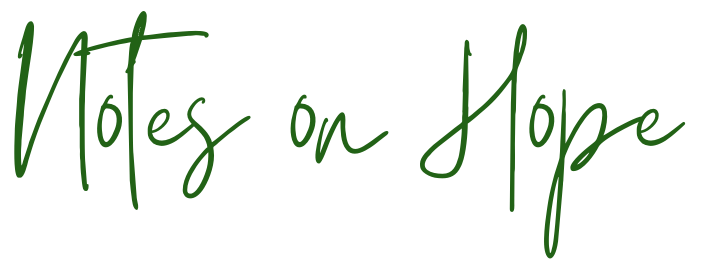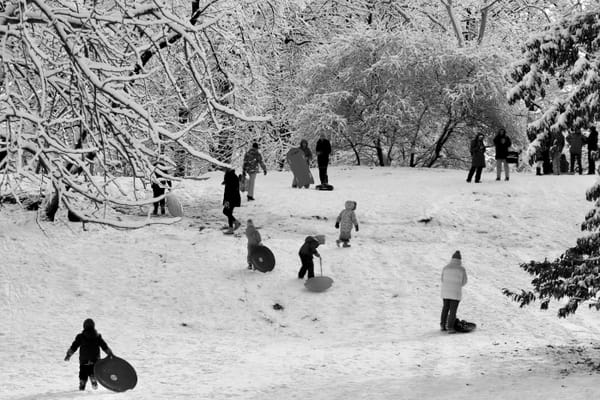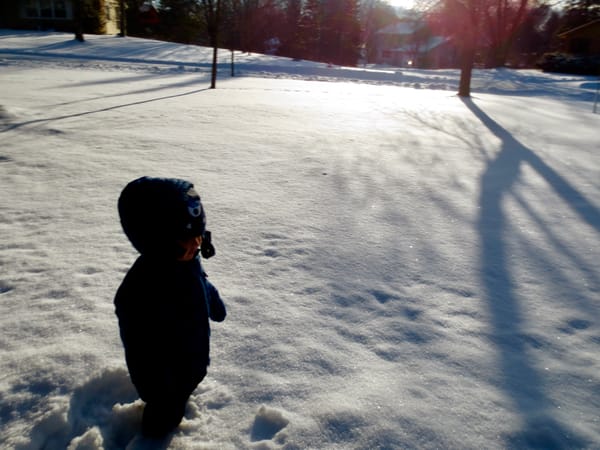Describing What's Possible
Finding language that inspires hope and creates possibility

“Although the wind
blows terribly here,
the moonlight also leaks
between the roof planks
of this ruined house.”
~Izumi Shikibu
translated by Jane Hirschfield with Mariko Aratani
I had a teaching colleague in a previous job who observed that we often describe children, without meaning to or even realizing the full impact of our words, in ways that close off possibilities for their growth and our ability to support them. He explained that, even when our descriptions are accurate and spoken with intended generosity and care, the specific language we use sometimes paralyzes a child’s progress, by casting their development in a veil of inevitability or by releasing us from our role, as adults, in nurturing a child’s growth. Importantly, the examples he provided of phrases that close off possibility were usually not derogatory or demeaning, but rather common ways of describing children with words as simple as, “young,” which can refer to a child’s age, but is also often a gentle code word teachers use to describe children who present in some way as immature for their age. Words like this, he argued, may be developmentally accurate, but they aren’t useful, because they don’t ask anything of us or create a vision of the future that helps us see what’s possible or what our role is.
Language that doesn’t ask anything of us also tends to create a permission structure for language that is increasingly subjective and dismissive and becomes less rooted in truth and more rooted in judgement over time. It is a short distance from describing a child as “young” to describing a child as “defiant” or “disengaged,” which are words that carry more negativity and have much more potential to establish self-fulfilling prophesies. Once we’ve given ourselves license to use words that release us from responsibility, even in seemingly benign or neutral ways, we more easily allow ourselves to slip from a position of passivity to a position of blame or even harm.
The antidote to allowing ourselves to slide down this path is two-pronged. The first step is to be alert to our own language, noting when we are using words that distance us from the individual or the issue we are trying to describe—to listen for what my colleague would term “dead-end” phrases, because these are the words that begin to close off a path forward, rather than committing to carving one out where the way may not yet be visible. The second step is to reframe the observation using language that holds possibility and that activities us. In most cases, the best way to do this is to ask a question. For example, in the context of teaching, instead of noting that a child or a group of children is “young,” we might ask, “What support do they need?” or “What obstacle can I remove?” The power of questions like this is twofold. First, questions almost always create openings more easily than definitive statements. When we are stuck in an observation that closes off possibilities, questions pull the weeds and the bramble away and begin to let in more light. Second, these particular questions ask something of us, not only of the child. They ask what actions are possible on our part to begin to transform an environment that constrains a child into an environment that offers options for expansion.

I’ve been thinking about this idea of identifying words and phrases that create dead ends and finding new language that opens up possibilities, because I believe this is something that applies beyond the classroom walls. As is often the case, the lessons that are offered in working with children carry over into our adult lives and into the wider world. Good teaching is dependent, in many ways, on the care we take with our language. The words we use to communicate with children, as well as the language we use with each other and in our own minds to motivate and conceptualize our work, are powerful. Language holds similar power in our day-to-day lives, especially as we respond to rapidly changing and often overwhelming circumstances.
The language we use doesn’t only convey our perspectives; the language we use also shapes our perspectives and our actions. There is a natural tendency to describe the world in ways that allow us to create a more comfortable distance between what we see happening and our responsibility to do something about what we see. Language can eliminate cognitive dissonance and make us feel safe, both literally and emotionally, by justifying our inaction or by protecting our egos and our self-perception. This is particularly true when we are in the midst of frightening events, when the world feels scary and out of our control, and when the scope of fear and suffering easily leads us to feel despair and a loss of agency. In these moments, it makes sense that we would reach for language that insulates us from risk and allows us to position ourselves at a safe distance, removed from taking on responsibilities and actions that increase our sense of vulnerability in practical or emotional ways.
The human drive to seek out safety and to grasp for vocabulary that soothes our worries and justifies our hesitance is entirely understandable. Our instincts lead us toward equilibrium and nudge us to protect ourselves and to create rational explanations for keeping ourselves safe. Our instincts also lead us to craft narratives, in both the language we share with others and the language we speak internally, that protect us from questioning our own retreat into safety and away from fear or discomfort. The ability to create reassuring, protective stories is one of the great powers of language. But the other great power of language is to ignite imagination by challenging our logic and by describing new possibilities.
Speaking recently about the risks of book bans, the children’s author and poet, Jason Reynolds, said of imagination,
“Our ability to reason isn't the only thing that exceptionalizes us in the animal kingdom but also our ability to imagine…The true matter at hand, this is a conversation about whether or not children—our children, all children—get to know what should not be a secret kept from them: that there is a world inside of them and there is a world outside of them, too, and that both of those are meant to spark their imaginations and activate their desires for more—more empathy, more compassion, more creativity and expression, more vocabulary, more justice, more fairness, more than what I've known or shown, more than what their parents have known or shown, more than what politicians and lawmakers have known or shown.”
Words have the power to protect us and to insulate us. But they also have the power to spark imagination and to invite us toward “more than we have known or shown.” Words can open up new pathways where we had previously only seen enclosures. They can create dead ends, but they can also carve a new way forward where there didn’t seem to be one. And questions are particularly effective at revealing openings that we may not otherwise have noticed or felt able to shape.
Just as teachers need to be alert to the ease with which we slip into dead-end language and inadvertently close off possibilities and step away from our responsibility to help children progress, I think we all need to be alert to dead-end language in our everyday lives and to the ways in which it allows us to insulate ourselves or to give in to inaction and despair. And, as we develop this habit of listening for the subtle indicators of passivity in our words, we also need to begin to develop a habit of re-framing our language, as good teachers do, by looking for questions that prompt our imagination. We can learn to replace statements that impose limitations with words that harness the possibility of our wonderings, especially when doing so creates discomfort or trepidation.
In education, we refer to the feeling of discomfort that emerges when children encounter ideas or experiences that challenge their previous understandings and move them toward new or deeper knowledge as disequilibrium. It can feel disconcerting to be in a state of disequilibrium, and at times children will back away from an experience that creates this feeling, or they will develop explanations that may seem illogical but that help them to hold onto the security of familiar ideas. But, with time, children revisit the ideas and experiences that provoked that feeling of discomfort with renewed questions and courage, because resolving confusion or frustration is compelling, and because their young brains have evolved to experiment, to grow, and to change. Children are natural questioners. Anyone who has spent time being peppered by the endless inquiries of a young child knows this! And teachers are also experts at luring children back to the sites of their misunderstandings and their curiosities to reengage, revise their thinking, and establish new pathways, both on a literal neurological level and in their imaginations.

In addition to prompting our imagination, the language that we choose also has the power to create pathways of hope where we might otherwise settle into despair. Hope and imagination are close allies, because hope isn’t just the ability to expect good things. Hope requires a commitment to imagine and work toward a future that is different from the present and to refuse to acquiesce to the passivity of what is, but instead to work toward the possibility of what might be. Hope necessitates that we ask questions that reveal new possibilities. Despair can feel surprisingly comfortable. Though it may sap us of pleasure, despair also offers us a sense of certainty that is extremely tempting. Hope, on the other hand, insists that we resist this certainty and allow for the discomfort of unknowns, because the potential for something better only resides within an embrace of what is not yet known or accomplished.
It is also important to understand that despair isn’t the only way to create a dead end. Just as in the example of observing children that I began with, sometimes even seemingly positive or benign language can close us off to possibilities, if it serves to alleviate our responsibility or to excuse our inaction. This is the “reckless optimism” or “desperate hope” that Hannah Arendt wrote about, which I’ve referenced in the past. Reckless optimism allows us to believe that a better future will take shape without our courage or participation—that it will somehow simply come to be. Language that minimizes harm, paints a rosy hue on an unacceptable status quo, or assures us that progress will happen on its own, or as a result of the efforts of others, can shape a perspective of reckless optimism that, much like despair, closes off our actions and allows us to simply wait out the present, rather than shape the future. But reckless optimism feels better than despair, so it can be harder to identify and resist.
Just as in the classroom, where teachers have to train themselves to note the paralysis that a simple observation can create and reframe it with a question that requires something more of us, we are living in a moment that requires each of us to commit to similarly training our mental pathways. We need to challenge ourselves to identify words that permit passivity and replace them with questions that insist on possibility and on our own active role in forging those possibilities.
Our language shapes what we are able to envision and it shapes our understanding of our responsibility in achieving that vision. Let’s all listen for words that close off possibilities, whether because they are devoid of hope or simply devoid of agency—whether they are the words we hear from others or the words we find ourselves saying to comfort our own restless minds—and let’s replace that language with questions that, instead, reveal new paths and ask something of us in establishing those paths.
The novelist and philosopher, Iris Murdoch, said of language,
“Words are the most subtle symbols which we possess and our human fabric depends on them. The living and radical nature of language is something which we forget at our peril.”
Words, and in particular questions, that inspire curiosity, imagination, perseverance, and possibility can move us forward and light the way for others. But words can also constrain us and grant us permission to remain comfortably immobile. This time in history demands that we listen closely for the difference and challenge ourselves to commit to choosing language that activates possibility and forward momentum. When we are tempted by passivity and dead ends, we must ask instead, “What is needed of me? What can I do?”
Wishing you questions that ignite hope, imagination, and action,
Alicia
A few things I found helpful and hopeful this week…
If fear is the goal, solidarity is the antidote
“The best antidote to fear is fellowship…We would do well to take refuge in each other. We can focus on the fear or we can focus on the acts of courage around us.”
What made you start caring?
“For someone who is — as I am — quite sensitive, often overwhelmed, easily angered, already so wrung out by these times, by all the cruelty and sorrow, by the endless chore that is of staying alive (let alone something resembling functional and … working) while also being a trans American…this whole experience has definitely given me unexpected … hope.”
The Superintendent of LA Schools stood up for kids
I should have included this last week, but I missed it! This is what courageous leadership that protects and advocates for children looks like. Please take a few minutes to watch!
A Humble Farewell
The final goodbye to Pope Francis at his funeral today was offered by a group of Rome’s most vulnerable—migrants, prisoners, unhoused individuals, and transgender people, as a reflection of his commitment to the vulnerable.
If you think someone else in your life might need some hope, please share. It’s always easier to hold onto hope when we’re not doing it alone.





